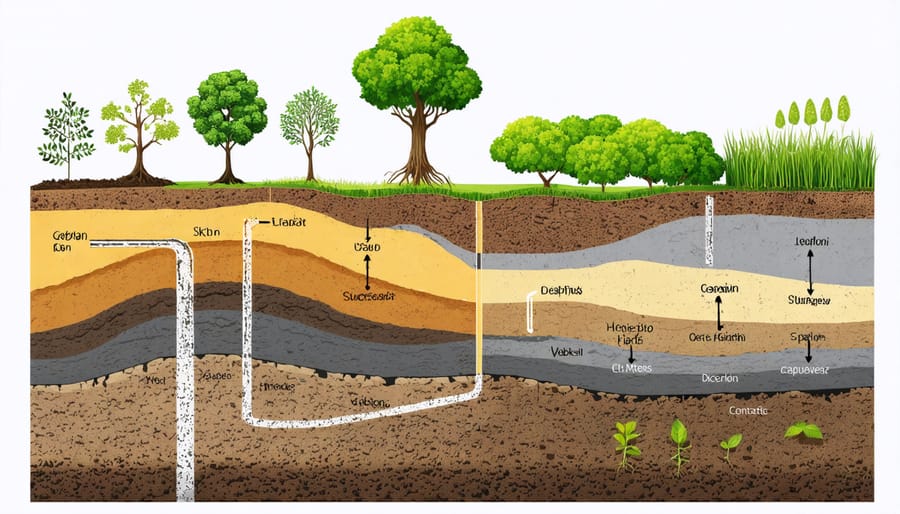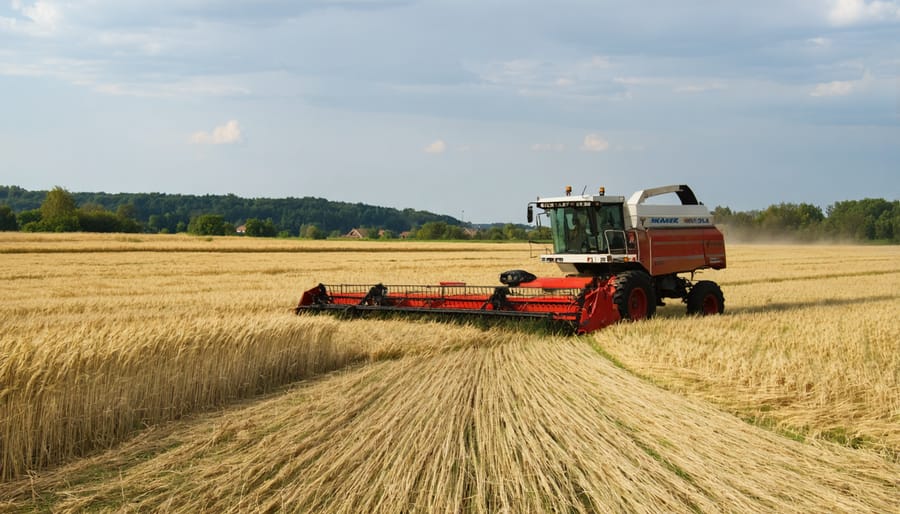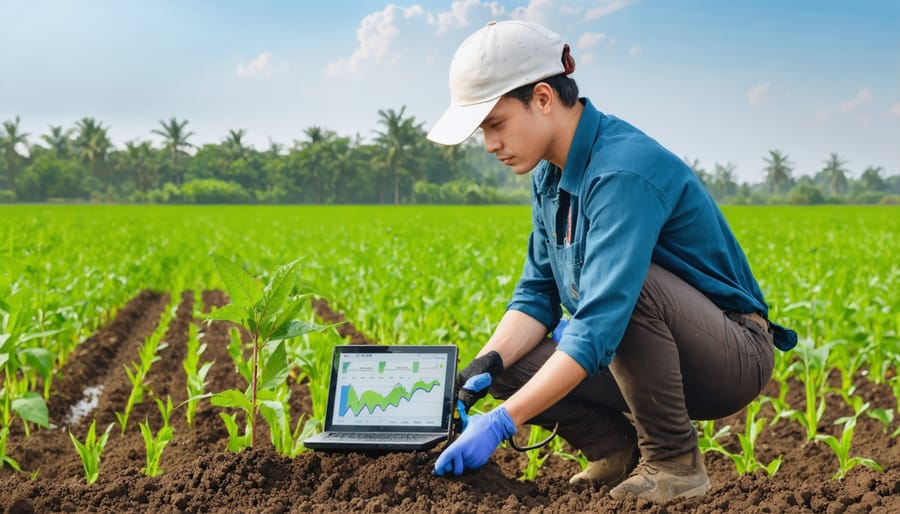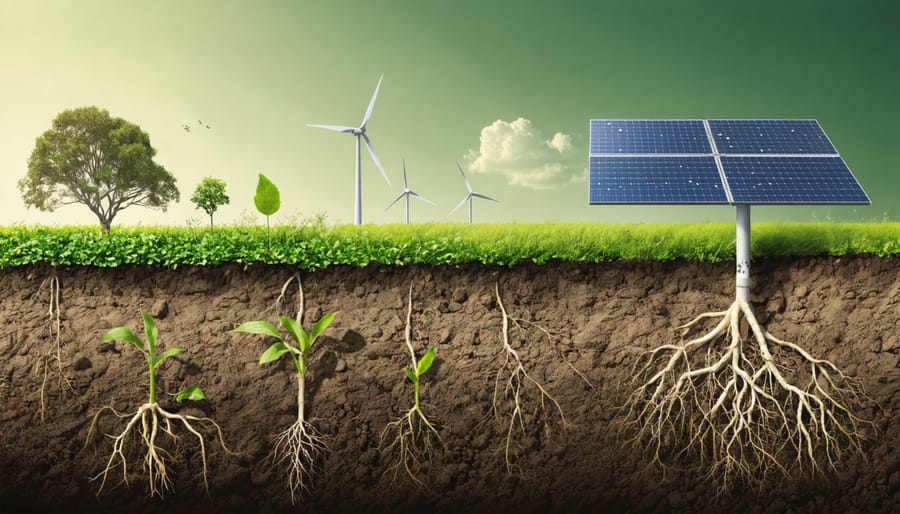Beneath our feet lies one of Earth’s most powerful climate solutions – a vast network of carbon cycling that could help us achieve carbon neutrality through biomass and natural processes. This dynamic system, moving billions of tonnes of carbon between soil, plants, and the atmosphere, represents both our greatest challenge and most promising opportunity in the fight against climate change.
Australian soils alone store an estimated 3.5 times more carbon than our atmosphere, yet this natural carbon bank remains largely untapped as a climate solution. Through innovative land management practices and emerging bioenergy technologies, we’re discovering new ways to enhance soil’s natural ability to capture and store carbon while simultaneously producing clean energy.
The relationship between soil carbon cycling and bioenergy production isn’t just about environmental benefits – it’s about creating resilient agricultural systems that serve multiple purposes. By understanding and optimizing this relationship, Australian farmers and energy producers are pioneering approaches that boost soil health, increase crop yields, and generate renewable energy, all while pulling excess carbon from the atmosphere.
The Science Behind Soil Carbon Storage

Understanding Carbon Sequestration
Soil carbon sequestration is nature’s own carbon capture technology, acting like a massive underground storage bank for greenhouse gases. When plants photosynthesize, they pull carbon dioxide from the atmosphere and transform it into organic matter. As plants shed leaves, die, or transfer nutrients through their root systems, this carbon-rich material becomes part of the soil.
The soil’s ability to store carbon depends on several factors, including soil type, climate, and land management practices. Sandy soils typically store less carbon than clay-rich soils, while healthy soils with abundant microorganisms can lock away carbon more effectively. In Australia’s diverse landscape, from the rich agricultural lands of Victoria to the red earth of the outback, different regions have varying carbon storage potential.
What makes soil carbon sequestration particularly valuable is its dual benefit: while helping to mitigate climate change, it also improves soil health, water retention, and agricultural productivity. Healthy soils with high carbon content are more resilient to drought, support greater biodiversity, and produce better crop yields. This natural process represents one of our most powerful tools in the fight against climate change, while supporting sustainable agriculture and ecosystem health.
Natural vs. Agricultural Carbon Cycles
In natural ecosystems, carbon cycling follows an ancient, well-balanced rhythm. Plants capture carbon through photosynthesis, store it in their tissues, and eventually return it to the soil through decomposition. This creates a rich, self-sustaining system where soil organic matter continuously builds up over time.
Agricultural systems, however, often disrupt this natural balance. Traditional farming practices like intensive tillage and monoculture can reduce soil carbon stocks by up to 50% compared to natural systems. Understanding these differences is crucial when considering the life cycle emissions of bioenergy crops and their impact on soil health.
The good news is that modern agricultural practices are increasingly mimicking natural systems. Cover cropping, minimal tillage, and crop rotation help maintain soil carbon levels while supporting productive farming. In many cases, these practices can even boost carbon sequestration above natural levels, creating what farmers call “carbon-positive” agriculture.
By understanding these contrasts, we can better design farming systems that maintain productivity while preserving – or even enhancing – soil carbon stocks, much like their natural counterparts.
Bioenergy Crops and Their Impact on Soil Health
Short-Rotation Energy Crops
Short-rotation energy crops are revolutionising the way we think about carbon sequestration and renewable energy production. These fast-growing plants, particularly willows and eucalyptus species, play a crucial role in enhancing soil carbon levels while providing sustainable bioenergy resources in Australia.
These remarkable crops can grow from seedling to harvest-ready in just 3-8 years, compared to traditional forestry cycles of 20-30 years. During their growth, they develop extensive root systems that contribute significantly to soil carbon storage. Willows, for instance, can penetrate deep into the soil, creating networks of fine roots that deposit carbon-rich organic matter throughout the soil profile.
The beauty of short-rotation crops lies in their dual benefit: they not only store carbon below ground but also provide a renewable energy source above ground. Australian farmers are increasingly incorporating these crops into their land management strategies, creating windbreaks and shelter belts that serve multiple purposes.
Research shows that soil under short-rotation energy crops can accumulate carbon at rates of 0.5-4 tonnes per hectare annually, depending on soil type and management practices. This carbon accumulation occurs through root turnover, leaf litter decomposition, and the stimulation of soil microbial activity.
The success of these systems depends on proper species selection and management. Native eucalyptus species, already well-adapted to Australian conditions, are proving particularly effective in combining rapid growth with excellent carbon storage capabilities. Many farmers are finding that these plantations can thrive on marginal land, turning previously unproductive areas into valuable carbon sinks while generating additional income through biomass production.
Perennial Grasses and Carbon Storage
Perennial grasses stand out as champions in the fight against climate change through their remarkable ability to store carbon in soil. Unlike annual crops that need replanting each season, perennial grasses develop extensive root systems that can reach several metres deep into the soil. These robust root networks act as natural carbon vaults, continuously depositing organic matter while keeping the soil structure intact year after year.
In the Australian context, native perennial grasses like Kangaroo Grass and Wallaby Grass have evolved to thrive in our unique climate conditions. When integrated into farming systems, these grasses can increase soil carbon content by up to 15-20% over a decade. This impressive carbon storage capability comes from their year-round growth pattern and minimal soil disturbance requirements.
The benefits extend beyond carbon sequestration. Perennial grass systems help prevent soil erosion, improve water retention, and create resilient agricultural landscapes that can better withstand drought conditions. Farmers who have embraced perennial pastures report increased soil organic matter, enhanced biodiversity, and reduced input costs.
Success stories from properties across Queensland and New South Wales demonstrate how strategic incorporation of perennial grasses into grazing systems has transformed degraded land into productive, carbon-rich soil. These transformations often begin showing positive results within the first three years of establishment.
Looking ahead, perennial grass systems represent a practical, nature-based solution for agricultural carbon sequestration. Their adoption not only supports sustainable farming practices but also contributes to Australia’s emissions reduction goals while improving farm productivity and soil health.

Best Practices for Maximising Carbon Storage
Crop Selection and Rotation Strategies
Selecting the right bioenergy crops plays a crucial role in maximizing soil carbon storage while maintaining sustainable energy production. In Australia’s diverse climate zones, certain crops have proven particularly effective at enhancing soil carbon levels while providing reliable biomass yields.
Fast-growing perennial grasses like miscanthus and switchgrass are excellent choices for carbon sequestration, as their extensive root systems can store significant amounts of carbon deep within the soil profile. Native Australian species such as kangaroo grass and wallaby grass have also shown promising results, particularly in regions with variable rainfall patterns.
Strategic crop rotation is equally important for maintaining soil health and carbon levels. A well-planned rotation might include alternating between deep-rooted perennial grasses and nitrogen-fixing legumes like lucerne or clover. This approach not only enhances soil carbon storage but also improves overall soil structure and nutrient availability.
For optimal results, consider implementing a three to four-year rotation cycle that includes:
– Two years of deep-rooted perennial grasses
– One year of nitrogen-fixing crops
– Optional year of cover crops for soil regeneration
Success stories from Queensland and Western Australia demonstrate that thoughtful crop selection and rotation can increase soil carbon levels by up to 15% over five years while maintaining consistent biomass production for bioenergy. These strategies work best when tailored to local soil conditions, climate patterns, and available resources.
Soil Management Techniques
Effective soil management during bioenergy production is crucial for maintaining and enhancing carbon storage. Australian farmers and energy producers have developed several successful techniques that boost soil carbon retention while supporting sustainable biomass cultivation.
Cover cropping has emerged as a standout practice, particularly in regions like Victoria and New South Wales. By planting nitrogen-fixing legumes between primary bioenergy crops, farmers maintain soil structure and add organic matter throughout the year. This approach has shown to increase soil carbon levels by up to 15% over five years.
Minimal tillage practices are another game-changer in soil carbon management. Many Australian bioenergy producers have adopted no-till or reduced tillage systems, which prevent soil disruption and protect stored carbon. Combined with strategic crop residue management, where portion of plant material remains on the field, these methods create a win-win situation for both energy production and carbon sequestration.
Biochar application has gained traction as an innovative solution. Created from agricultural waste through pyrolysis, biochar not only improves soil structure but also provides long-term carbon storage. Forward-thinking farmers in Queensland have reported improved water retention and increased crop yields after incorporating biochar into their soil management strategy.
Rotational grazing, particularly in areas where bioenergy crops are integrated with livestock systems, helps maintain soil health through natural fertilization and prevents overgrazing, which can lead to carbon loss. This holistic approach demonstrates how traditional farming wisdom can complement modern bioenergy production.

Monitoring and Measuring Success
Modern soil carbon monitoring combines traditional sampling methods with cutting-edge technology to track changes effectively. Farmers and researchers across Australia now use sophisticated soil probes that measure carbon content, moisture levels, and microbial activity in real-time. These smart sensors transmit data to cloud-based platforms, providing valuable insights into soil health and carbon sequestration rates.
Regular soil testing remains crucial, with samples typically collected at different depths and locations across a site. Many landholders are adopting a systematic approach, establishing permanent monitoring points and conducting assessments every six to twelve months. This consistent data collection helps track progress and adjust management practices accordingly.
Satellite imagery and drone technology have revolutionised large-scale monitoring, offering cost-effective ways to assess vegetation cover and soil characteristics across vast properties. These tools can identify areas of high carbon storage potential and track changes in soil organic matter over time.
Success in soil carbon cycling is measured through various indicators, including organic matter content, bulk density, and microbial biomass. Many Australian farmers are now participating in carbon credit schemes, where accurate measurement is essential for verification and trading purposes. The emergence of user-friendly mobile apps and digital platforms has made it easier for land managers to record, analyse, and share their soil carbon data, creating a collaborative approach to monitoring and improvement.
Future Opportunities for Australian Agriculture
Carbon Farming Credits
Carbon farming credits represent a growing economic opportunity for Australian landholders and farmers who implement sustainable soil management practices. Through carbon offset initiatives, farmers can earn additional income by sequestering carbon in their soil while improving land productivity.
The Australian Carbon Credit Unit (ACCU) scheme rewards farmers for practices that enhance soil carbon storage, such as reduced tillage, cover cropping, and strategic grazing management. These credits can be sold to businesses and organisations looking to offset their emissions, creating a win-win situation for both the environment and agricultural communities.
Success stories from pioneering farmers across the country show that carbon farming can generate between $20 to $40 per hectare annually through carbon credits, while simultaneously improving soil health and crop yields. The market for soil carbon credits is expected to grow significantly, with major corporations increasingly committed to achieving net-zero emissions targets.
For farmers considering this opportunity, the first step is typically conducting a baseline soil carbon assessment and developing a management plan that aligns with carbon credit methodologies.
Emerging Technologies
Cutting-edge technologies are revolutionizing how we monitor and enhance soil carbon cycling. Remote sensing satellites now provide real-time data on soil carbon levels across vast landscapes, enabling farmers and researchers to track changes with unprecedented accuracy. Advanced soil sensors, equipped with machine learning capabilities, offer instant analysis of soil composition and carbon content right in the field.
Biochar technology has emerged as a game-changer in Australian agriculture, with innovative processing methods making it more accessible to farmers. These new techniques can transform agricultural waste into carbon-rich soil amendments while producing renewable energy as a bonus.
Precision agriculture tools, including GPS-guided equipment and drone mapping, help farmers optimize carbon sequestration practices. These systems can identify areas requiring specific attention and automatically adjust farming practices to maximize carbon storage potential.
Emerging microbial technologies are also showing promise, with scientists developing specialized bacterial and fungal communities that enhance soil carbon storage. These biological innovations, combined with advanced monitoring systems, are creating a new frontier in soil carbon management, offering hope for more effective climate change mitigation strategies.
Soil carbon cycling stands as a crucial frontier in our fight against climate change and our pursuit of sustainable agriculture. Through understanding and actively managing soil carbon processes, we can unlock tremendous potential for both environmental restoration and agricultural productivity. The evidence is clear: healthy soils rich in organic carbon not only support more resilient ecosystems but also contribute to Australia’s growing bioenergy sector. By implementing the practices discussed – from regenerative farming techniques to innovative carbon monitoring methods – we can all play a part in enhancing soil carbon storage. Whether you’re a farmer, policymaker, or concerned citizen, the time to act is now. Let’s work together to build a future where healthy soils support thriving communities and a sustainable energy landscape. Your next step could be as simple as supporting local initiatives or adopting carbon-smart practices in your own backyard.

